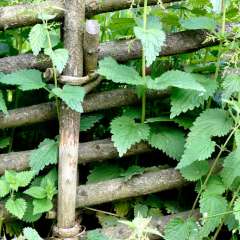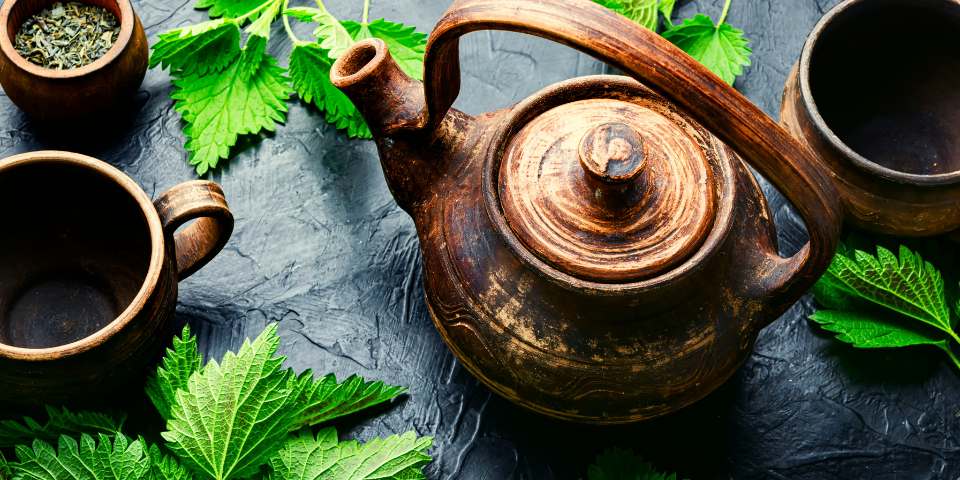Stinging nettle, scientifically known as Urtica dioica, is a herbaceous perennial plant that has been used for centuries for its various health benefits. Although known for its stinging hairs that cause a temporary uncomfortable sensation upon contact, this plant holds a treasure trove of medicinal properties that are worth exploring.
While often overlooked, stinging nettle offers a range of remarkable health benefits that can enhance your overall well-being and support specific medical conditions. In addition, stinging nettle is a nutritious edible herb that can bring multiple benefits to your survival garden.
About the Stinging Nettle Plant
Stinging nettle is thought to have originated in the colder regions of Europe and Asia, but today is found all over the world. This perennial flowering plant grows between 2 and 4 feet tall and blooms from June to September producing yellow or pink flowers.
The plant is rich in vitamins like A, C, K, and several B vitamins. It is full of calcium, iron, magnesium, phosphorus, potassium, and sodium as well as all essential amino acids. Nettle also contains a high amount of polyunsaturated fatty acids including linoleic acid which is an omega-6 fatty acid that boosts the immune system helping it resist infections as well as having anti-oxidant properties. While kale and spinach may be more popular "superfoods", stinging nettle is a nutritional powerhouse.
For centuries, stinging nettle also has been grown as a fiber plant for creating textiles. Because it is high in nitrogen it can be used to create fertilizer for your garden.
Health Benefits of Stinging Nettle
For hundreds of years, stinging nettle has been used as an herbal medicine to treat health conditions such as painful muscles and joints, eczema, arthritis, gout, and anemia. Today, nettle is often used to treat urinary problems and the early stages of an enlarged prostate gland known as benign prostatic hyperplasia (BPH).
Stinging nettle contains a variety of compounds that can help to reduce inflammation making it useful for treating arthritis and other inflammatory conditions. It can benefit people with diabetes because nettle contains compounds that mimic insulin which may help stabilize blood sugar levels. Studies have shown that an extract of stinging nettle is also useful in reducing the effects of some seasonal allergies.

Stinging nettle was traditionally used to treat high blood pressure as it produces active compounds that can act as vasodilators relaxing the muscles of your blood vessels. It also has compounds that can act as calcium channel blockers, which help your heart relax reducing the force of contractions.
Nettle is one of the oldest recorded herbal remedies for treating and preventing hair loss due to the high amount of sulfur and silica in nettle, which supports hair growth by strengthening the hair shaft. For treatment rinse hair with nettle tea or you may find commercially available nettle shampoo.
Nettle leaf tea has been proven to be an excellent natural support for women's health. For ages, it has been used to support milk supply in lactating women. It has diuretic properties that may help prevent urinary tract infections, and its astringent properties can ease menstrual cramps and bloating.
Use caution when using nettle for issues like diabetes or blood pressure as it can interact with blood thinners, diuretics, and diabetes medications. Always seek medical advice before adding herbal supplements to your health regimen if on medication.
How to Prepare Nettle Leaves
The first step in dealing with stinging nettle leaves is to wear skin protection. The leaves have small stinging hairs that can cause irritation and even an allergic reaction. Leaves can be washed and air-dried, dehydrated, or freeze-dried for long-term storage. They can also be frozen. To freeze nettle leaves, blanch them first in boiling water for 2 minutes and then soak in ice water for 2 more minutes. Freeze blanched leaves in a roomy freezer bag.
Nettle Leaf Tea
There are commercially available nettle leaf tea bags available on the market, but it is easy to make your own. Bring 10 ounces of water to a boil and add a teaspoon of dried nettle or a tablespoon of fresh nettle leaves to the water. Allow the water to steep for 5 to 10 minutes, strain, and serve. Nettle tea has a fresh grassy flavor. The Arthritis Foundation recommends a cup of nettle tea 3 times a day to treat the pain and inflammation from arthritis.
Stinging Nettle in the Garden

Nettles don't only provide potential health benefits for us humans, but they are a great source of nutrients for our gardens. Nettles are high in nitrogen so they are a great fertilizer for leafy vegetables like kale, spinach, and Swiss chard. You can make an organic liquid plant food by stuffing nettle leaves in a bucket or container and weighing the leaves down with bricks or stones. Fill the bucket with water and allow it to steep for a month. Mix 1 part of the nettle liquid with 10 parts water to water your plants for a growth-boosting fertilizer.
Growing nettles as a companion plant can attract beneficial insects like ladybugs as well as ladybugs' favorite food, aphids. Use nettles as a bait plant to lure aphids away from nearby crops. Caterpillars and butterflies love nettles as well.
Prune nettles and lay the cuttings around larger plants for mulch or add it to compost, as its nitrogen will speed up the decomposition process. Be careful not to include nettle roots or seed heads as you'll end up with nettles growing in your compost pile.
How to Grow Stinging Nettle
Seeds can be sown in flats in late winter and should germinate in about 14 days. Nettle seeds require light for germination so gently sprinkle seeds onto the soil and cover them with a very thin layer of soil. Seedlings can be transplanted outdoors as soon as the soil can be worked in early spring. Space them about 8 inches apart.
Nettle is very hearty and will thrive in a variety of climates and conditions. It will grow in partial shade to full sun and can tolerate a soil pH of anywhere between 5.0 and 8.0. Soil does have to be moist. If it is too dry it will slow the growth of the plants and may affect the potency of the plant for medicinal purposes. Soil should be high in nitrogen as well.
Caution
Stinging nettle is an aggressive spreader through underground stolons and is considered an invasive species in much of North America. You can keep the spread in check by removing flowers when they appear, regular harvesting, and sowing in containers or enclosed garden spaces. It is a good idea to cut back dead stalks in the fall to prevent self-seeding in your garden.
Are you looking for a natural way to improve your health and well-being? Growing stinging nettle may be the answer you are looking for. While it may be known for its unpleasant sting, this powerful plant offers a wide range of potential benefits that can enhance your overall health.

























